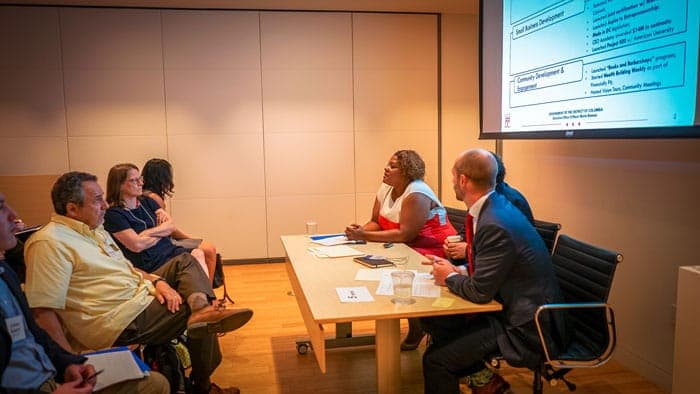
News
By Administrator, July 27, 2016

Courtney Snowden, Deputy Mayor of Economic Opportunity for Washington, DC speaks as part of a panel at the third annual Local Leaders Council Policy Forum in Washington, DC. Photo by Ted Eytan on Flickr.
Development can do great things for a city—as long as neighborhoods can keep their communities and their culture intact. That’s the philosophy guiding the work of Courtney Snowden, Washington DC Deputy Mayor for Greater Economic Opportunity, and Conan Smith, Commissioner of Washtenaw County, MI, who spoke about “Revitalization without Displacement” at the 2016 Local Leaders Council Policy Forum on July 19, 2016 in Washington, DC.
Revitalization without Displacement was one of three tracks at this year’s Forum, where nearly 30 speakers talked about a wide range of smart growth topics, including creating catalytic development, creative placemaking, “missing middle” housing, and working with developers. “Jumpstarting revitalization” and “Place-based Economic Development” were the other two main tracks.
Snowden and Smith joined the first breakout session in the Revitalization without Displacement track. Moderating the discussion was Alex Hutchinson, who runs Smart Growth America's Revitalization without Displacement technical assistance program. Snowden and Smith's experiences working in Washington, DC and Detroit brought two very different perspectives to the table. Yet despite their entirely different economic climates, both cities are struggling to maintain affordable rent and provide reliable employment and opportunities for financial growth to residents of their lower-income neighborhoods.
Conan Smith—who in addition to being a Washtenaw County Commissioner is also the Executive Director of Metro Matters, a nonprofit coalition of city governments in the Detroit region—focused on intergovernmental cooperation and discussed how in former industrial cities gentrification can actually be a good thing because there’s very little displacement. In fact, he explained that industrial cities are often desperate for gentrification to bring growth. With growth coming to downtown neighborhoods in Detroit, homeowners are finally seeing their property values rise with little rise in property taxes. Because of rising rents, Commissioner Smith admits, the main challenge with gentrification is that renters are now struggling to find affordable places to live.
“We need to make sure people can grow with their neighborhood,” Smith noted, and policymakers and developers will both be necessary parts of the solution. People who can afford to stay despite rising rents can also protect their neighborhood’s culture. Detroit's biggest challenge moving forward, Smith believes, is how to revitalize neighborhoods with a high concentration of poverty—many of which are actually growing in Detroit. As other parts of the cities gentrify, he explained that Detroit must now focus on rethinking the workforce system to create real opportunities for employment for the people in these neighborhoods.
While Detroit can take advantage of the ample space available for redevelopment, Washington, DC is running out of such space. Courtney Snowden, DC's Deputy Mayor for Greater Economic Opportunity, expressed deep love for the city that has always been her home but admitted the serious challenges Washington faces as it experiences a huge influx of growth. “We had no idea this was going to happen as quickly as it did,” she explained. With a net growth of 1,000 new residents every month, rents are rising at an astronomical rate, hurting longtime low-income residents the most. Wards 7 and 8 have just 3 grocery stores for 200,000 people, while the newly redeveloped H Street NE corridor will have 5 grocery stores in just 12 blocks. “I took this job because I saw my city changing in a way I didn’t like,” she explained.
The city is now focusing intensive resources on communities that have been overlooked and underserved, working to help low-income residents connect to opportunities for employment and pathways to the middle class. To do this, Deputy Mayor Snowden’s office has developed a number of programs to grow resident-owned businesses and keep the rents for those businesses affordable. “Small businesses are the economic engines that drive communities,” Snowden explained, “and when they are owned and employed by residents, they can revitalize a community while also protecting its residents."
How do you help residents remain in their neighborhood even as the city as a whole changes? Snowden and Smith agree that better access to education and employment are key. At the same time, cities can work with developers to protect neighborhood culture in the long term. While both cities are still struggling with affordability in the face of redevelopment, focusing public programs and resources on often overlooked lower-income neighborhoods can make a big difference in protecting neighborhoods and preparing their residents for all of the changes coming to their cities.
Related News

© 2025 Smart Growth America. All rights reserved
Site By3Lane Marketing










